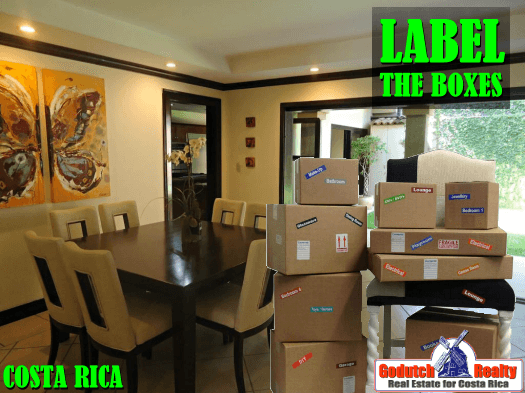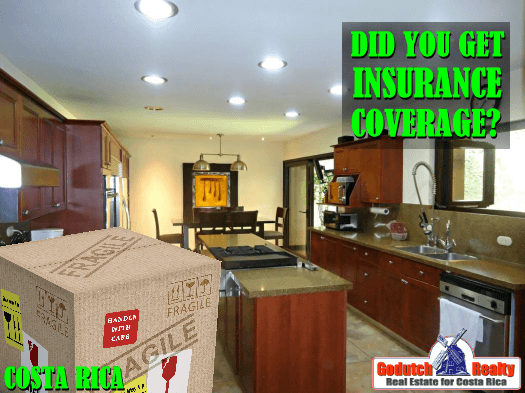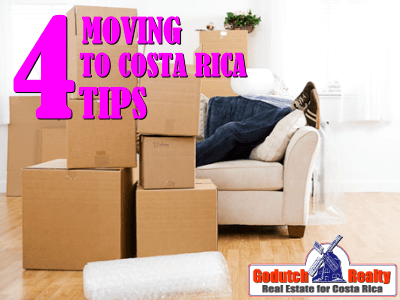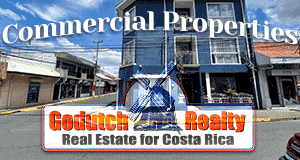Estimated Reading Time: 8 Minutes
I titled this blog, “our tips for moving to Costa Rica” it easily could have been titled “our moving nightmare.”
It seems that even when you are careful, get recommendations, and follow expert advice, everything still can go to heck in a handbasket.
I have already covered some tips for moving to Costa Rica in my previous blogs. So I will skip over much of the detail and just hit a few of the relevant “lowlights.” Even though we were careful and went by the book, there are things that happened to us that you may be able to avoid.
After soliciting moving quotes, we selected an experienced Costa Rican international mover given to us by a trusted “recommender.” This C.R. mover was bonded as was their U.S. agent that packed us in California. We also wanted to get insurance on our load. Because bonded agents are required to allow the client’s possessions to be insured while stored and in transit. The following 4 tips for moving to Costa Rica are based on these experiences.
4 Tips for Moving to Costa Rica
1. The shipping manifest
The first of 4 tips for moving to Costa Rica is a huge one. If you don’t do this right, it will cost you a lot of money.
Bonded movers are required as part of their bond to pack and box everything; label each item or box with a number; and identify it and its contents on a shipping manifest they create.
Our movers were at our house in California for three and one-half days inventorying, packing, crating, labeling, and physically moving our belongings out of the house and into their moving truck. One problem we had was Spanish was their first language (only one of the movers spoke some English and he was not the foreman). This proved to be a significant communications obstacle as the foreman had the final say and made all of the decisions for the crew. We were never certain if our questions or wishes were being fully comprehended and acted upon.
If you can, insist when contracting with your mover that the moving crew speaks your language. (Here, perhaps, one could argue for our learning Spanish before we left California.)

A communication obstacle
This proved to be a significant communications obstacle as the foreman had the final say and made all of the decisions for the crew. We were never certain if our questions or wishes were being fully comprehended and acted upon. If you can, insist when contracting with your mover that the moving crew speaks your language. (Here, perhaps, one could argue for our learning Spanish before we left California.)
Costa Rican customs
We watched the process as carefully as we could between interruptions, but as it turned out, our crew loaded 42 items more than were listed on the manifest. When it was finally counted by Costa Rica customs when the container was unpacked in Costa Rica, there were 42 more items than the amount entered on the manifest. For instance, there were three bundles of garden tools that had only one number and only one line entered on the manifest. If you do nothing else, be certain that each and every item or box has a separate number and is entered separately on the shipping manifest. Not having this match-up when being unloaded caused some of our essential items to be held by customs for an additional six months.
If you do nothing else, be certain that each and every item or box has a separate number and is entered separately on the shipping manifest. Not having this match-up when being unloaded caused some of our essential items to be held by customs for an additional six months.
2. Moving insurance coverage
I mentioned our desire to ensure our possessions and there are three types of moving insurance coverage available when bringing your belongings here in a shipping container.
Basic insurance
Basic insurance is included with your container shipment by the shipping company at no additional cost and covers the whole load, on the sole occurrence that the ship sinks at sea and your whole load is lost.
By weight
“By weight” insurance where you can get insurance on your whole load for any losses incurred during storage or its transit by sea. This is the most comprehensive and the most expensive.
By value
Value inventory covers a specific insured inventory, which you create before the move giving a replacement value to specific items. This list is given to your bonded mover, who arranges for this insurance. Usually, you include in this insured value inventory your most expensive or irreplaceable items and give them each an insured value.
Our best option was insurance option #3: value inventory.
We first capped our insurance limit at $30,000, for coverage which would cost us about $1,050. Then, we made our list of items we wanted to get insurance, gave them a value, and then pared the list or the item value down until we had an insured list of items with replacement values totaling $30,000. It was surprising when doing this list of how many of our items had to be left off of the valued inventory in order to cap the coverage at $30,000.

3. An extremely long move
When everything was finally delivered and compared to the manifest there were a number of items damaged or missing. I suppose when you think that we moved out of our house in February 2013. The final delivery wasn’t made to our house in Costa Rica until April 2014. So having missing items was not all that surprising.
Our possessions went a long way:
- They went from our house into boxes and then into a moving truck.
- Those boxes were then trucked 320 miles and unloaded onto shelves and pallets in a bonded warehouse.
- Then they were left there for five months, to be loaded into a shipping container.
- From there, the container was transported to the dock in San Pedro, CA.
- When it arrived there, it was then unloaded for a U.S. Customs exit inspection.
- After the inspection, it was all reloaded into a container, sent to a bonded warehouse at the dock.
- At the dock, it was loaded by crane onto a ship and sent through the Panama Canal to the port of Limon, Costa Rica.
- In Costa Rica, it was unloaded by customs and sent to a bonded warehouse in San Jose.
- From the bonded warehouse the container was loaded onto moving trucks and driven 45 kilometers to our house and unloaded.
All of this caused our belongings to be moved many times and touched by many hands.
 4. Inventory of damaged and missing items
4. Inventory of damaged and missing items
Last but not least of my tips for moving to Costa Rica. We put together our list of damaged, broken, and missing items. Our estimate to replace or repair everything came to $5,600. However, our insured valued inventory included only a part of the missing and damaged items. The “value inventory” claim we have submitted is $2,800 less the $250 deductible. We made our best effort to negotiate our loss claim and on the insurance company’s final offer $2,140.
My recommendations
Think hard about how much of your belongings you want to insure. Find the time to take photos and make descriptions of your valued possessions. It will ultimately save you lots of time and grief. But most of all, it will put your negotiations with the insurance company, if required, on much firmer ground. I hope these 4 tips for moving to Costa Rica will be of any help to you. You might be able to save yourself a lot of headaches.
The Author
The author of this blog, Ticonuevo, is a US expat who moved to Costa Rica. Ticonuevo used the services of GoDutch Realty to purchase a property in Costa Rica. In his blogs, Ticonuevo describes his own experiences of taking the step of moving to Costa Rica and getting a new life started.
























